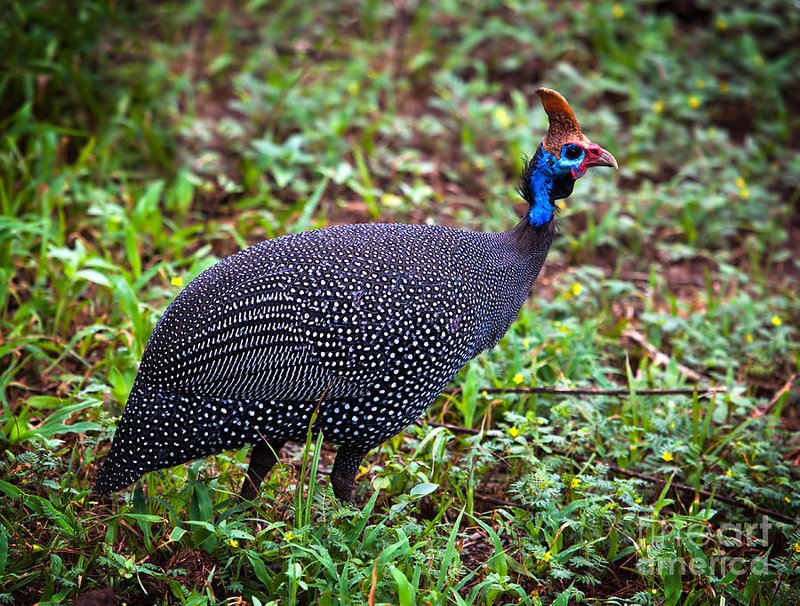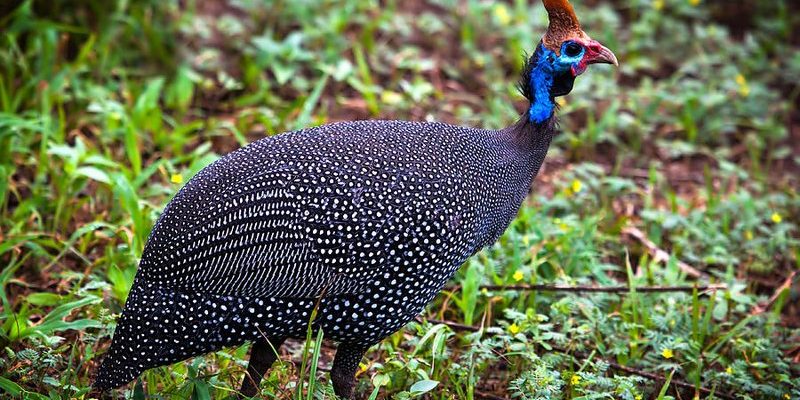
Have you ever spotted a bird that looks like it stepped out of a history book? That’s the guineafowl for you! These fascinating birds are known for their striking appearance and unique behaviors. With their spotted feathers and distinctive calls, they can catch anyone’s attention, whether they’re in the wild or wandering through a farmyard. Native to Africa, guineafowl are not just pretty faces; they also bring a lot of interesting traits to the table.
Imagine a feathered little watchdog—that’s what guineafowl can be! They are excellent at alerting you to danger, thanks to their loud and raucous calls. Plus, they have a knack for keeping pests at bay, making them valuable friends to have around. Whether you’re a bird enthusiast or just curious about wild animals, the guineafowl has plenty to offer in terms of intrigue and character.
Physical Characteristics of Guineafowl
Guineafowl are hard to miss. Most species have a distinctive plumage covered in white spots against a dark background, which can range from bluish to grayish. The helmeted guineafowl, one of the most common types, stands about 24 inches tall and weighs 2 to 3.5 pounds. They sport a small, bony casque on their heads, giving them a quirky look that adds to their charm. Their long legs and rounded bodies allow them to run swiftly, making them quite agile.
One of the standout features of guineafowl is their skin, which is bare around their necks and head. This nudity might seem strange, but it helps regulate their temperature in the African heat. Their feathers can also vary slightly between species; for instance, the vulturine guineafowl sports vibrant blue and white plumage, setting it apart from its cousins. Overall, these birds are a delightful mix of beauty and practicality.
Behavior and Social Structure
Guineafowl are social creatures that thrive in groups. You might see them foraging together for food, which usually consists of seeds, insects, and small plants. They communicate through a series of loud calls, which can sound like a mix of clucks and squawks. Their keen senses help them stay alert for predators, making them excellent at warning their flock of danger. They also have a fascinating hierarchy; within a group, you’ll often find dominant birds that set the tone for the rest.
These birds are primarily terrestrial, meaning they prefer to stay on the ground rather than take to the air. You might be surprised to learn that while guineafowl can fly, they do so only for short distances. This preference for the ground allows them to forage efficiently and keep their eyes peeled for any potential threats lurking nearby.
Habitat and Distribution
Guineafowl are primarily found across sub-Saharan Africa, adapting to a variety of habitats, from savannas to open woodlands. They thrive in areas with abundant vegetation, providing ample food and shelter. In some regions, they might also be seen in gardens or farms, where their presence is often welcome due to their pest-control abilities.
What’s intriguing is their adaptability. While they prefer dry climates, guineafowl can also be found in slightly wetter environments, provided there’s enough shelter. As they wander through their habitats, they play a vital role in the ecosystem, helping to manage insect populations and aerate the soil as they scratch around.
Diet and Feeding Habits
You might be wondering what guineafowl actually eat. Well, these birds are omnivores, which means they enjoy a diverse menu. Their diet mainly consists of seeds, grains, insects, and even small invertebrates. They spend a good portion of their day foraging for food, scratching at the ground with their powerful legs. It’s like watching a small, feathered vacuum cleaner at work!
Guineafowl have a unique way of locating their meals. They use their excellent eyesight to spot food from a distance, and their sharp beaks help them pick and pry at the ground. Interestingly, they also consume small stones, which help grind up food in their gizzards, aiding in digestion. It’s essential for them to have the right balance of nutrients, so their varied diet plays a big part in their health.
Reproduction and Nesting
When it comes to reproduction, guineafowl are somewhat traditional. The breeding season varies depending on their location, but it usually occurs during the warmer months. A male guineafowl will court a female by engaging in elaborate displays, showcasing his vibrant plumage and performing vocalizations to attract her.
After mating, the female will build a nest on the ground, often hiding it among tall grass or underbrush to protect her eggs from predators. She typically lays between 6 to 15 eggs, which incubate for about 26 to 28 days. Once the chicks hatch, they are precocial, meaning they can walk and forage almost immediately. This early independence is crucial for survival, as they are vulnerable to various predators.
Conservation Status
As of now, guineafowl are not considered endangered, but their populations can vary based on habitat loss and hunting pressures. In some areas, they are farmed for their meat and eggs, which can help stabilize their numbers. However, in the wild, environmental changes can threaten their habitats, making conservation efforts essential.
Organizations dedicated to wildlife conservation are working hard to ensure that guineafowl continue to thrive in their natural habitats. Educating local communities about the importance of these birds can also play a significant role in protecting them. By promoting sustainable practices and reducing habitat destruction, we can help secure a future for guineafowl.
Interesting Facts About Guineafowl
| Common Name | Guineafowl |
| Scientific Name | Numida meleagris |
| Size | 24 inches tall |
| Weight | 2 to 3.5 pounds |
| Habitat | Sub-Saharan Africa – Savannas and Woodlands |
| Diet | Seeds, insects, small plants |
| Lifespan | 10 to 15 years |
| Flight | Short distances only |
Guineafowl as Pets
If you’re considering adding a guineafowl to your backyard, there are a few things to keep in mind. First, these birds can be a delightful and entertaining addition. They are known for their curious nature and can often be amusing to watch as they interact with each other and their environment. However, they are not like traditional pets; their needs are a bit different, so preparation is key.
Guineafowl require space to roam and forage, so having a large, enclosed area is essential. Providing shelters for them to roost at night will keep them safe from predators. Additionally, since they are social creatures, it’s best to have more than one bird to keep them happy. Just like humans thrive on social interaction, guineafowl do too!
Common Challenges with Guineafowl
While guineafowl can be a rewarding addition to your home or farm, they do come with their own set of challenges. They can be quite loud, especially during breeding season, which might not be appreciated by your neighbors. Knowing how to manage their raucous calls can be essential to maintain peace.
Another challenge is that guineafowl can be quite adventurous. They may try to escape their enclosures to wander, which can lead them into dangerous territory if not supervised. Regular fencing checks and providing engaging environments help mitigate these issues. It’s about ensuring their safety while allowing their natural curiosity to thrive!
FAQ
What is the difference between guineafowl and chickens?
Though they might appear similar at first glance, guineafowl and chickens have distinct differences. Guineafowl are generally more colorful and have unique patterns in their feathers. While both birds can be found on farms, guineafowl are better at controlling insect populations and are often considered more resilient to diseases.
Can guineafowl fly?
Yes, but not for long distances. Guineafowl are primarily ground-dwelling birds and usually fly short distances to escape predators or reach high perches. They can take off from the ground, but their flight capabilities are limited compared to other birds.
Are guineafowl social animals?
Absolutely! Guineafowl thrive in social groups and prefer to live in flocks. They communicate with each other through various calls and rely on their flock mates for safety. If you’re planning to keep them, it’s best to have at least a few together.
How do guineafowl help farmers?
Guineafowl are excellent pest controllers! They feed on insects, including ticks and beetles, which can cause harm to crops. Their foraging behavior helps maintain a balanced ecosystem, making them valuable allies for farmers looking to reduce pesticide usage.
What do guineafowl eat in the wild?
In their natural habitats, guineafowl have a varied diet consisting of seeds, fruits, and insects. They forage on the ground, using their sharp beaks to dig and scrape for food. This natural diet is essential for their health and well-being.
How long do guineafowl live?
Guineafowl typically live between 10 to 15 years in the wild, though domesticated birds can sometimes live longer with proper care. Factors such as diet, shelter, and protection from predators all play a vital role in their lifespan.
Are guineafowl good pets for children?
While guineafowl can be a fun addition to a family, they might not be the easiest pet for young children to handle. They are more suited for older kids who can understand their need for space and how to interact with them safely. Always supervise interactions to ensure the safety of both the children and the birds.
Can guineafowl keep other birds safe?
Yes, guineafowl are known for being vigilant guard birds. Their loud calls can alert other animals, including chickens or smaller pets, about approaching dangers like predators. This protective behavior adds an extra layer of security to mixed animal farms.
Do guineafowl require special care?
Guineafowl don’t require excessively complicated care, but they do need a safe and spacious environment, social interaction, and a balanced diet. Regular check-ups and a clean living space will help keep them healthy and happy.
What is the typical breeding behavior of guineafowl?
During mating season, male guineafowl engage in elaborate courtship behaviors to attract females. After mating, the female will build a nest on the ground, laying several eggs that will need to be incubated for about a month before hatching.
Where can I learn more about guineafowl?
A great way to dive deeper into the world of guineafowl is by exploring wildlife documentaries, visiting local farms that raise them, or joining birdwatching groups. Many books and online forums are dedicated to bird enthusiasts, providing a wealth of information!

